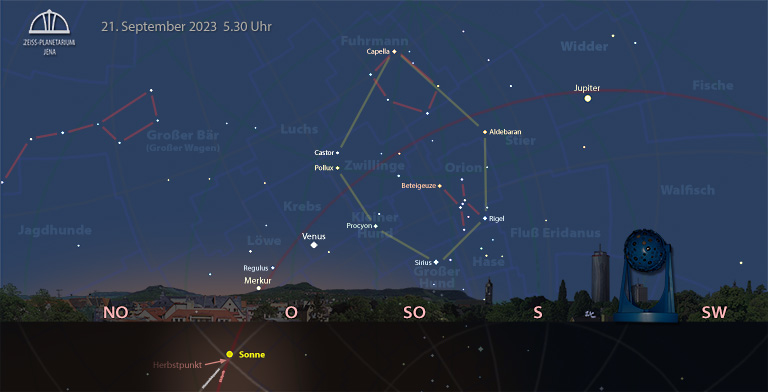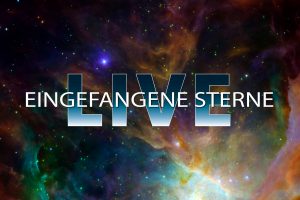Der Herbst beginnt
Am 23. des Monats verabschiedet sich mit der Tagundnachtgleiche der diesjährige Sommer astronomisch und kalendarisch, bei uns auf der Nordhalbkugel beginnt der Herbst. Von Jena aus gesehen quert die Sonne um 8:48 Uhr Sommerzeit den Himmelsäquator in Richtung Süden. Sie hat am 17. das Tierkreissternbild Löwe verlassen und ist vor die Jungfrau gezogen.
Vollmond ist am 29. September, Neumond am 15.
Fast die ganze Nacht sind die Planeten Saturn und Jupiter zu sehen. Saturn bewegt sich rückläufig, also von Ost nach West, vor dem Tierkreissternbild Wassermann. Jupiter bewegt sich ab 4. rückläufig vor dem Tierkreissternbild Widder.
Am Sternhimmel der ersten Nachthälfte vollzieht sich ebenfalls der Wechsel der Jahreszeiten. Noch dominiert im Südwesten das prachtvolle Sommerdreieck, das die hellen Sterne Deneb im Schwan, Wega in der Leier und Atair im Adler bilden.
Aber aus dem Osten ziehen bereits die leider nicht so lichtstarken Sterne des Herbstvierecks auf, die gegen Monatsende den mitternächtlichen Sternhimmel beherrschen werden. Sie gehören zu den Sternbildern Pegasus und Andromeda. Dieses Viereck ist ein nahezu perfektes Rechteck und so leicht zu entdecken. Die obere Kante führt als Sternkette der Andromeda in den Osten, hin zum Helden Perseus. Darüber funkelt als Himmels-W das Sternbild Kassiopeia. Später erscheinen im Osten bereits die Sterne des Wintersechsecks: Kapella, Aldebaran, Rigel, Sirius, Prokyon sowie Kastor und Pollux.
Merkur wird ab 19. bis Ende des Monats tief am Osthimmel sichtbar. Venus strahlt sehr hell als sogenannter „Morgenstern“ im Osten am Morgenhimmel.
W. Don Eck
Zeiss-Planetarium Jena
Autumn begins
On the 23rd of the month, the equinox marks the astronomical and calendrical end of this year’s summer, and autumn begins here in the northern hemisphere. Seen from Jena, the sun crosses the celestial equator towards the south at 8:48 a.m. summer time. It left the zodiacal constellation of Leo on the 17th and moved in front of Virgo.
Full moon is on 29 September, new moon on 15 September.
The planets Saturn and Jupiter are visible almost all night. Saturn moves retrograde, i.e. from east to west, in front of the zodiac constellation Aquarius. Jupiter moves retrograde from the 4th in front of the zodiac constellation Aries.
In the starry sky of the first half of the night, the change of seasons is also taking place. The magnificent summer triangle, formed by the bright stars Deneb in Swan, Vega in Lyra and Atair in Eagle, still dominates in the southwest.
But from the east the unfortunately not so bright stars of the autumn quadrangle are already moving in, which will dominate the midnight sky towards the end of the month. They belong to the constellations Pegasus and Andromeda. This quadrangle is an almost perfect rectangle and so easy to spot. The upper edge leads as the star chain of Andromeda to the east, towards the hero Perseus. Above it, the constellation Cassiopeia sparkles as a celestial W. Later, the stars of the winter hexagon appear in the east: Capella, Aldebaran, Rigel, Sirius, Prokyon and Castor and Pollux.
Mercury becomes visible low in the eastern sky from the 19th until the end of the month. Venus shines very brightly as the so-called „morning star“ in the eastern morning sky.
W. Don Eck
Zeiss Planetarium Jena
Eingefangene Sterne – Live
Der Sternhimmel über Jena und monatlich wechselnde Themen
Mi · 06.09. · 19.00 Uhr
Sa · 23.09. · 16.00 Uhr
Wir berichten live über den aktuellen Sternhimmel und helfen Ihnen dabei Sterne und Sternbilder zu entdecken. Weiterhin informieren wir Sie über die neuesten Entdeckungen und Entwicklungen in Astronomie sowie bahnbrechende Erkenntnisse über unser Universum und aktuelle Unternehmungen in der Raumfahrt. Monatlich vertiefen wir ein spezielles Thema. Ausdrücklich erwünscht sind Ihre Fragen, Anregungen oder Themenwünsche, die Sie an sternelivefragen@planetarium-jena.de richten oder live in der Veranstaltung äußern können.
Captured Stars – Live
The starry sky over Jena and monthly changing topics
Wed – 06.09. – 7:00 pm
Sat – 23.09 – 4:00 pm
We report live about the current starry sky and help you to discover stars and constellations. Furthermore, we inform you about the latest discoveries and developments in astronomy as well as groundbreaking findings about our universe and current ventures in space travel. Every month, we delve into a special topic. We expressly welcome your questions, suggestions or topic requests, which you can send to sternelivefragen@planetarium-jena.de or express live at the event.



